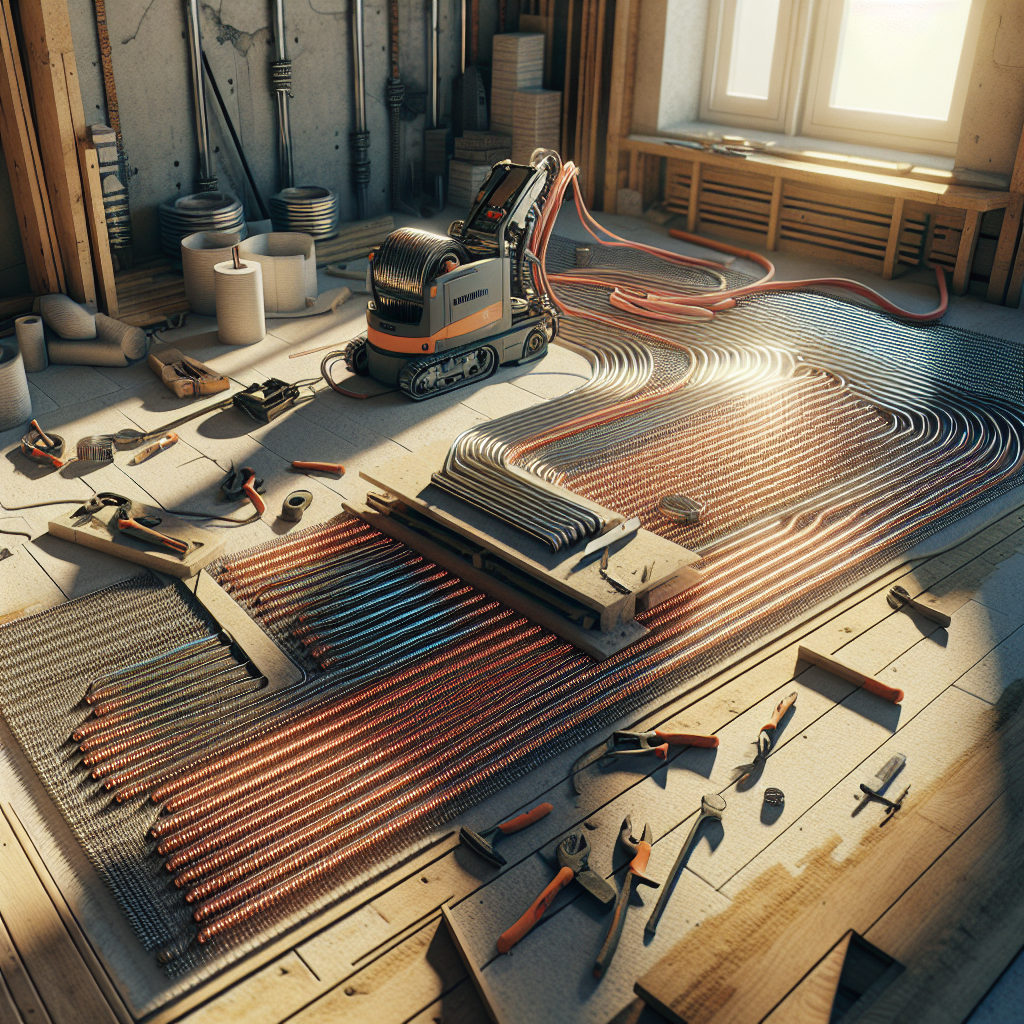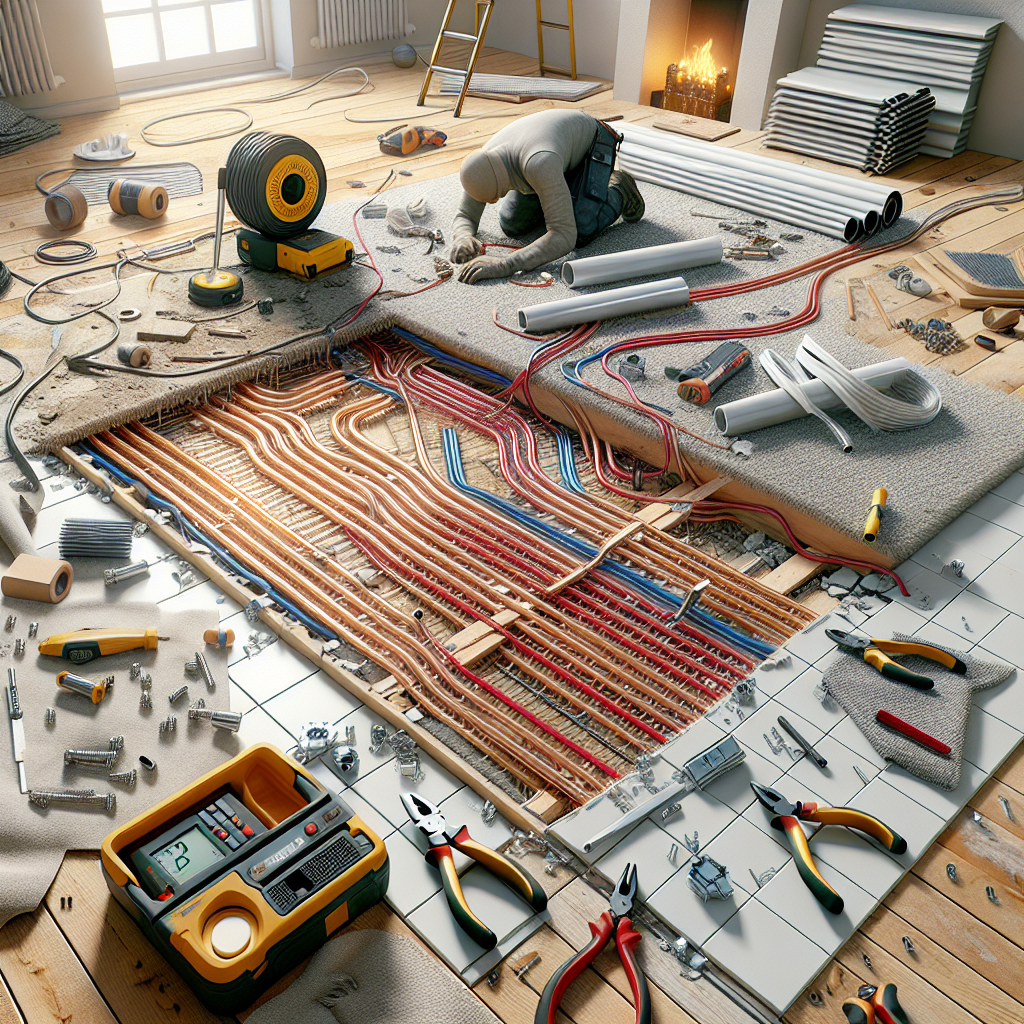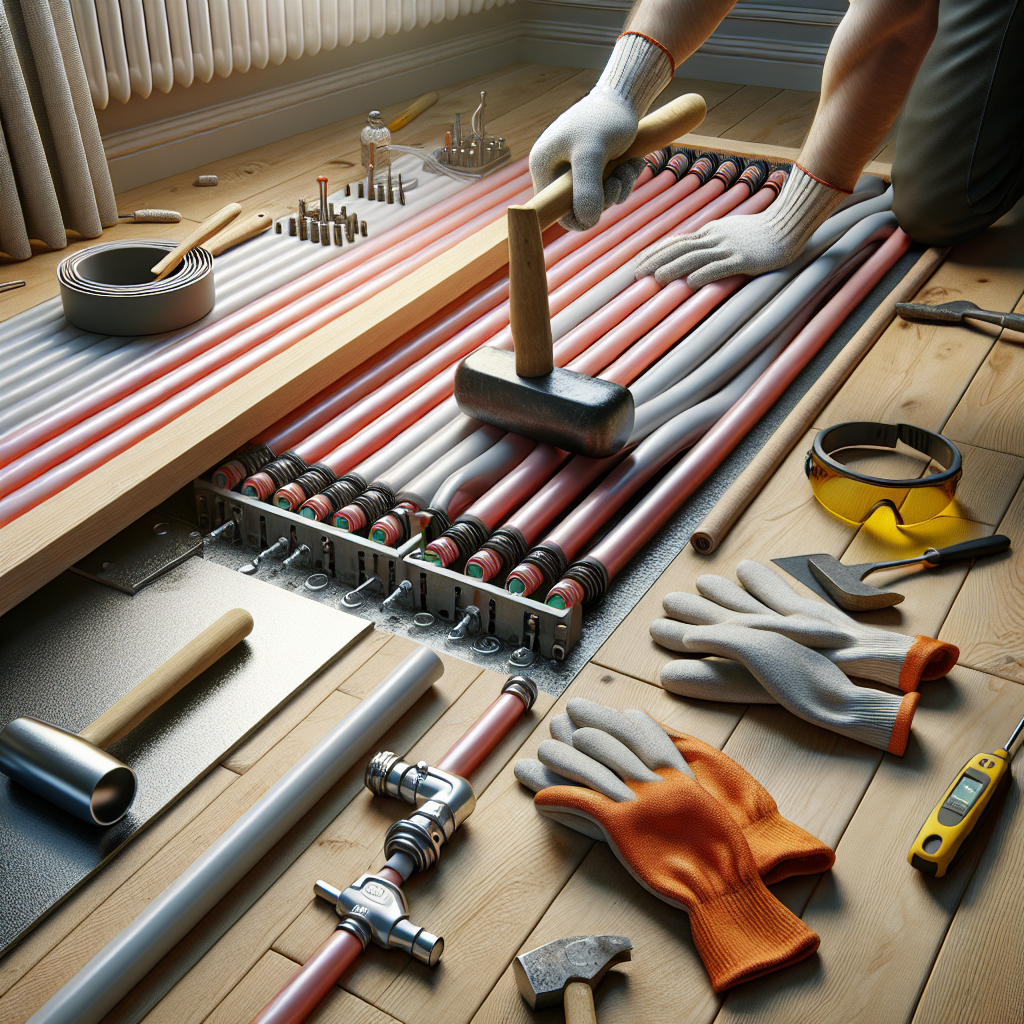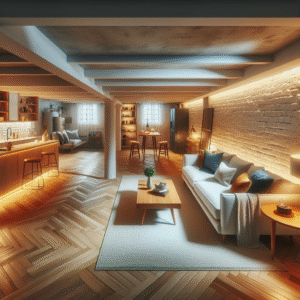Discovering the Warmth of Radiant Floor Heating: A Smart Upgrade for Home Comfort
Radiant floor heating, an innovative system designed to warm your home from the ground up, has increasingly become a popular choice among homeowners seeking comfort and efficiency. Unlike traditional heating systems that heat air, radiant systems work by directly warming the floors of your home, providing a cozy, even heat that rises gently. The benefits of this system are manifold, including even distribution of heat, reduced allergens, and energy efficiency, making it an attractive option for those looking to enhance their living space.
Introduction to Radiant Floor Heating: Benefits and Basic Principles
Radiant floor heating offers a slew of advantages that go beyond simple comfort. Firstly, it is highly efficient, as it minimizes the loss of heat often seen in duct systems and provides heat directly where you need it. Additionally, this type of heating reduces the circulation of allergens, making it a healthier choice for those with respiratory issues. The basic principle behind radiant heating involves installing heating elements beneath your floor, which can be powered by electricity, air, or water. These elements heat up the floor, which then radiates warmth throughout the room without any noise or drafts.
How to Install Radiant Heating in Different Types of Floors
Whether you have tile, hardwood, or carpet, there’s a radiant floor heating solution that can be tailored to your home’s specific needs. The installation process varies based on the type of floor and the source of heat (electric vs. hydronic), each providing unique benefits and challenges.
Choosing the Right Radiant Heating System for Your Home: Costs, Materials, and Installation Tips
Choosing the right system involves understanding the upfront costs, ongoing energy consumption, and the compatibility of materials with your existing floors. It’s important to consult with a local professional who can provide insights tailored to your home’s specifications and the local climate conditions.

If you’re ready to take your home improvement or construction project to the next level, we can help! Find trusted contractors on BuildNet, whether you’re looking for renovations, new builds, electrical work, plumbing, or anything in between. Our directory connects you with qualified professionals who can make your vision a reality.
Introduction to Radiant Floor Heating: Benefits and Basic Principles
Have you ever stepped out of a cozy bed onto a chilly floor on a cold morning? It makes you want to jump right back under the covers! Imagine a world where your floors greet you with warmth. That’s the magic of radiant floor heating. In this article, we’ll dive into what radiant floor heating is, explore its benefits, and understand the basic principles behind this modern comfort enhancer.
What is Radiant Floor Heating?
Radiant floor heating is a system that provides heat directly to the floor of your home. It’s like the sun’s rays warming the ground; only in this case, the warmth is coming from beneath your feet. This heating method not only adds a luxurious touch to your home but also provides a uniform distribution of heat, keeping the lower half of the room pleasantly warm.
Types of Radiant Floor Heating Systems
- Electric Radiant Floors: These systems use electric cables built into the floor. Ideal for retrofitting under tile or within new constructions.
- Hydronic Radiant Floors: These systems are more cost-effective for whole-house heating and use heated water flowing through tubes under the floor.
Top Benefits of Radiant Floor Heating
Radiant floor heating boasts numerous advantages that go beyond mere comfort. Here’s why you might want to consider installing it in your home:
- Energy Efficiency: Radiant heating is more efficient than traditional baseboard heating and usually more efficient than forced-air heating because it eliminates duct losses.
- Non-Allergenic: Since this system doesn’t rely on blowing air through vents, it doesn’t circulate dust or allergens within the home.
- Quiet Operation: Unlike traditional heating systems that can produce noise as they cycle on and off, radiant floor heating operates silently.
- Even Heating: The heat from a radiant floor heating system is distributed evenly across the floor, eliminating cold spots and providing consistent comfort.
- Increased Home Value: Homes with radiant floor heating are often more appealing to potential buyers, making it a worthwhile investment.
Basic Principles of Radiant Floor Heating
To really appreciate the brilliance of radiant floor heating, it’s essential to understand its basic operating principles. Here’s a simple breakdown:
Conduction and Radiant Energy Transfer
At its core, radiant floor heating is all about conduction (direct heat transfer from a hot to a cooler surface) and radiant energy (heat transfer through electromagnetic waves). When you turn on the system, either electrical coils or heated water tubes beneath the floor warm up. The heat then conducts from these elements to the floor material and finally radiates up into your room, warming everything it touches.
Zone Heating Control
One of the standout features of radiant floor heating is the ability to control the temperature in different zones of your home independently. This means you can keep the living room cozy while maintaining a cooler temperature in the bedrooms, optimizing comfort and energy use.
Is Radiant Floor Heating Right for You?
Whether radiant floor heating suits your home will depend on various factors including your current heating system, floor type, and budget constraints. Consider these points:
- Installation Costs: While installation can be pricier than traditional heating systems, the long-term savings on energy bills can offset the initial investment.
- Compatibility: Not all flooring materials are suitable for radiant heating. Tile and concrete are best, while some types of wood might not be ideal.
- Home Construction: Installing radiant floor heating is easier in new construction but can be integrated into existing homes, particularly during remodeling.
Embracing radiant floor heating can transform your living space into a warm, inviting haven. It’s an efficient, comfortable, and luxurious addition to any home, and considering its benefits, it’s definitely worth exploring further. So, if you’re ready to step onto a warm floor every morning, radiant floor heating might just be the next project for your home renovation list!

How to Install Radiant Heating in Different Types of Floors
Are you contemplating a cozy upgrade to your home with radiant floor heating? Smart choice! Not only does it distribute heat evenly across your rooms, but it also offers a stealthy, efficient heating solution without interfering with your home’s aesthetics. Now, let’s dive into how you can embrace this warmth, depending on the type of floors you have or plan to have. Whether you’re laying down new tiles or sprucing up your hardwood floors, there’s a radiant heating solution just for you.
Prepping for Installation
Before you jump into buying heaters and tearing up floors, it’s crucial to plan. Start by assessing your existing floor condition and structure. Older homes may need some subfloor reinforcement before proceeding. Also, consider consulting with a local professional to ensure compliance with building codes and to secure any necessary permits—this is a step you definitely shouldn’t skip to ensure everything is up to snuff and safe.
Installation in Tile Flooring
Tiles and stones are naturally excellent conductors of heat, making them the perfect pair for radiant heating systems. Here’s how to integrate radiant heating with your tile flooring:
- Subfloor Preparation: Ensure your subfloor is clean, level, and free of cracks. Repair any imperfections to prevent future damage.
- Heating Mat Installation: Roll out the electric heating mats directly onto the subfloor. These mats should be tailored to fit your room’s dimensions and should be connected to the appropriate power source.
- Thermal Layer: Apply a thin layer of mortar over the mats to help with heat distribution and protect the heating elements.
- Laying Tiles: Once the mortar is set, you can begin laying your tiles as usual. Ensure that the adhesive and grout are compatible with the heating system.
Double-check with a local installer or retailer who can provide specific recommendations for the types of adhesives and mortars best suited for heated floors, enhancing the longevity and effectiveness of your installation.
Installation in Laminate and Wood Flooring
Wood and laminate floors require a bit more caution with radiant heating to prevent warping and drying. However, with the right system and careful installation, you can enjoy warm wood floors without worry:
- Choose the Right System: For wood and laminate, it’s best to use a hydronic (water-based) radiant heating system, as it provides a more gentle heat suitable for wood materials.
- Subfloor Preparation: As with tile, start with a level and clean subfloor. For wood installations, consider laying a layer of plywood or backer board over the original subfloor to provide stability.
- Installing the Heating System: Hydronic systems usually require a network of pipes to be laid before the final flooring is installed. It’s crucial to ensure that the pipes are properly insulated and secured to avoid any shifting.
- Laying Wood or Laminate: Once your heating system is tested and confirmed leak-free, you can proceed to install your wood or laminate flooring according to the manufacturer’s instructions.
Remember to keep the temperature under your wood floors moderate to prevent any potential damage. Consulting with a specialist who understands the specifics of combining wood floors with radiant heating is a great way to ensure the longevity of your floors and heating system alike.
Installation in Concrete Floors
Installing radiant heating in concrete floors is popular in new constructions but can also be retrofitted into existing homes. Here’s how to handle concrete:
- Embedding the System: For new constructions, heating tubes or electric mats can be embedded directly into the concrete slab. For existing floors, the slab may need to be cut to embed the system before being resealed.
- Insulation is Key: Before installing the radiant heating elements, laying an insulation layer beneath is crucial to ensure heat is directed upwards rather than being lost to the ground.
- Pouring Concrete: Once your heating system is in place, the concrete can be poured over. Ensure an even spread to avoid any hot or cold spots in the floor.
This method can be a bit more intensive, so it’s highly recommended to work with professionals who have experience with concrete and radiant heating installations to get the best results.
Connecting with Local Experts
No matter which type of flooring you choose, connecting with local experts can make a significant difference in the success of your radiant floor heating installation. Professionals can offer tailored advice, recommend the best materials and techniques for your specific situation, and ensure that your installation is both safe and effective.
By leveraging local knowledge and expertise, you’re not only getting a top-notch installation but also helping support your local economy—a win-win in our book!
So, are you ready to step into the world of warm, comfortable floors? Whether you’re remodeling or building new, incorporating radiant floor heating is an investment in comfort and home efficiency. Choose your floor type, consult your local experts, and get ready to enjoy the toastier side of life!
Choosing the Right Radiant Heating System for Your Home: Costs, Materials, and Installation Tips
Hey there! If you’re considering adding a radiant heating system to your home, you’re on the path to enjoying cozy, energy-efficient warmth underfoot. Let’s dive into how you can select the perfect system that balances cost, materials, and practical installation advice. Whether you’re renovating or building new, understanding these elements will ensure you make an informed choice that suits your home and budget.
Understanding the Types of Radiant Heating Systems
First things first, radiant heating systems come in two main types: electric and hydronic. Each type has its own set of benefits and considerations:
- Electric Radiant Floors: These systems use electric cables or mats to generate heat. They are ideal for smaller areas like bathrooms or kitchens due to their ease of installation and lower upfront cost.
- Hydronic Radiant Floors: These systems employ hot water running through tubes to heat your space. They’re more cost-effective for larger areas or entire homes and can use a variety of energy sources to heat the water.
Choosing between electric and hydronic systems will depend on your heating needs, the size of the project, and energy costs in your area.
Factors Influencing the Cost of Radiant Heating Systems
When budgeting for radiant heating, it’s crucial to consider both the initial installation costs and the long-term operating costs:
- Installation Costs: These can vary widely based on the type of system (electric vs. hydronic), the size of the area to be heated, and the complexity of the installation. Electric systems are typically less expensive to install but might be more costly to operate than hydronic systems.
- Operating Costs: These depend on the type of energy used (electricity, gas, solar, etc.) and the efficiency of the system. Hydronic systems generally have lower operating costs, especially if they are hooked up to an efficient boiler or solar water heating system.
Don’t forget to consider the longevity and maintenance costs of the system you choose. Hydronic systems, for instance, may require more maintenance but typically have a longer lifespan than electric systems.
Choosing the Right Materials for Radiant Heating
The materials used in your radiant heating system play a crucial role in its efficiency and effectiveness. Here’s what to consider:
- Flooring Materials: Tile and concrete are the best conductors of heat, making them excellent choices for radiant heat systems. Wood and laminate can also be used but require careful consideration regarding heat transfer and potential expansion or contraction.
- Insulation: Proper insulation beneath the radiant heating elements is crucial to ensure that the heat rises into your room effectively rather than escaping downward.
Choosing the right materials will not only enhance the efficiency of your heating system but also ensure that it integrates seamlessly with the aesthetic of your home.
Installation Tips for Radiant Heating Systems
Installing a radiant heating system can be a significant project, and while DIY options exist, professional installation is often recommended. Here are some tips to ensure a smooth installation process:
- Choose a Qualified Installer: Look for a contractor with experience in installing radiant heating systems. Checking local directories like BuildNet can help you find trusted professionals in your area.
- Consider Your Home’s Layout: Before installation, think about where the heating zones will be. Open layouts might need different considerations than a home with lots of divided rooms.
- Plan for the Future: If you’re renovating, consider whether future changes to your home’s layout could affect the heating system. Installing extra tubing or wiring in a new build can save you from having to redo your floors later.
Proper planning and professional help can make installing a radiant heating system a rewarding investment, increasing your home’s comfort and value.
Local Considerations and Final Thoughts
Lastly, think about your local climate and energy costs. Homes in colder regions will benefit significantly from radiant heating systems, potentially seeing higher energy savings and enhanced comfort. Also, local incentives or rebates for energy-efficient home improvements can further offset your initial investment.
Choosing the right radiant heating system involves a balance of upfront costs, material choices, and thoughtful installation. By considering these factors, you can ensure that your home is warm and cozy for years to come, without breaking the bank.

What is Radiant Floor Heating and How Does It Work?
Radiant floor heating is a system that provides heat directly to the floor or to panels in the wall or ceiling of a house. The system relies on infrared radiation to heat objects and people in the room from the ground up, which can be more efficient than traditional heating systems that heat the air. This method ensures an even distribution of heat, reducing cold spots and enhancing overall comfort.
What Are the Benefits of Installing Radiant Floor Heating?
The benefits of radiant floor heating are numerous:
- Energy Efficiency: Radiant heating systems can be more energy-efficient than traditional forced-air systems because they minimize the loss of heat.
- Comfort: They provide consistent and even heat throughout the room, eliminating cold spots.
- Aesthetics: With no radiators or air vents, your home will have a cleaner, more streamlined appearance.
- Health: Radiant heating reduces the circulation of allergens and dust, which is beneficial for those with allergies.
Can Radiant Floor Heating Be Installed Under Any Type of Flooring?
Radiant floor heating systems can be installed under various types of flooring, including tile, stone, laminate, wood, and carpet. However, the efficiency and effectiveness of the system can vary depending on the flooring material’s thermal conducting properties.
How Cost-Effective is Radiant Floor Heating?
Initial installation costs for radiant floor heating can be higher than traditional heating systems. However, the operational costs can be lower over time due to its higher energy efficiency. Many homeowners find that the comfort and energy savings justify the initial investment.
What Should I Consider When Choosing a Radiant Heating System?
- Type of Installation: Options include electric systems, which are generally easier and cheaper to install but more expensive to run, and hydronic systems, which are more costly to install but cheaper for heating larger spaces.
- Size and Layout of Your Home: The dimensions and layout will determine the complexity and cost of installation.
- Compatibility with Flooring: Certain types of flooring work better with radiant heating systems and optimize the heat distribution.
Is DIY Installation Possible for Radiant Floor Heating?
While some electric radiant systems are designed for DIY installation, it’s generally recommended to hire a professional, especially for hydronic systems. Improper installation can lead to inefficient heating or damage to your flooring.
How Long Does a Radiant Heating System Last?
With proper installation and maintenance, a radiant heating system can last up to 35 years or more. The longevity depends on the type of system and the quality of installation.
How Do I Maintain My Radiant Heating System?
Maintenance requirements for radiant heating systems are generally minimal. Keeping the boiler or water heater (for hydronic systems) in good condition and ensuring the thermostat and other controls are working properly are the main concerns. Regular checks will ensure maximum efficiency and longevity.
Can Radiant Floor Heating Increase My Home’s Value?
Yes, radiant floor heating can potentially increase your home’s value due to its efficiency and the luxury of having uniformly distributed heat. It’s a selling point that appeals to many homebuyers.
Conclusion
If you’re considering upgrading your home with radiant floor heating, you’re making a choice that combines comfort with efficiency. While the upfront costs might seem high, the long-term savings and increase in property value are tangible benefits that make this investment worthwhile. Remember, choosing the right type of radiant heating system and ensuring it’s properly installed are crucial. For more personalized advice and to ensure you get the best set-up for your home, don’t hesitate to reach out to a local contractor through our directory at BuildNet. Getting a free quote from a qualified professional can help you make the right decisions and start enjoying a warmer, more comfortable home in no time. Here at BuildNet, we’re ready to connect you with the right experts for your project!







